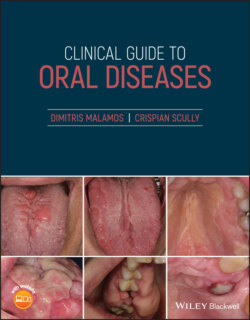Читать книгу Clinical Guide to Oral Diseases - Crispian Scully - Страница 25
2 Blue and/or Black Lesions
ОглавлениеBlue and black oral lesions have been characterized by increased pigmentation due to accumulation either of melanin (true) or hemosiderin, metals, chemical coloring agents and drug metabolites (non‐true discoloration) within the oral mucosa and teeth. These lesions may be manifestations of a group of congenital or acquired diseases with traumatic, reactive, neoplasmatic, and infective origin (Figure and 2.0ab).
The most common causes of black or blue pigmentation are listed in Table 2.
Figure 2.0a Blue lesion.
Figure 2.0b Black lesion.
Table 2 The most common causes of blue and black lesions.
| Pigmentation |
| Related to melanin (brown, black lesions)Increased melanin production only Related to race Racial pigmentosawRelated to hormone alterations ChloasmaAddison diseaseEctopic ACTH productionNelson syndromeAcanthosis nigricansLaugier‐Hunziker syndromeLeopard syndromeSpotty pigmentation, myxoma, endocrine overactivity syndromeVon Recklinghausen's diseaseAlbright syndromeRelated to consumption of DrugsFoodsRelated to exposure in sunFrecklesSolar lentiginesRelated to smoking habitsBetel nut chewingSmoker's melanosis Related to inflammationLP metachrosisBMMP metachrosisEM metachrosis Related to various factorsEphelides (simple)Ephelides in Peutz‐Jegher syndrome Increased number of melanocytesLentigines simplexNeviMelanoma Related to hemosiderin (blue, red lesions)AngiomasKaposi's sarcomaEpithelioid angiomatosisEcchymosisHemochromatosis/hemosiderosisBeta thalassemia Related to foreign material (gray, black lesions)ArgyriaHeavy metal poisoning (lead, bismuth, arsenic)Permanganate or silver poisoningTattoos (amalgam, lead pencils, ink, dyes, carbon) |
